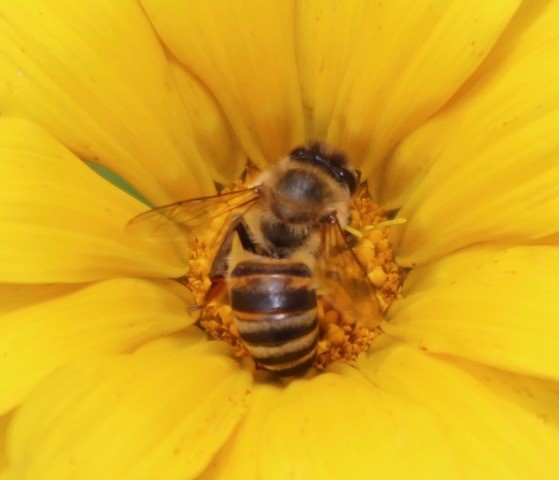Bee Blog January
01 January 2019
I am Gerald Bushby (pronounced bush bee!) a beekeeper in Weston on the Green, a small village in Oxfordshire. I am going to be writing a monthly blog about the bees in my apiary. I hope you will find it interesting. I should start by saying that I am not an expert, having only kept bees for three years. Anything I say is my own personal opinion; I accept that there may often be other views and opinions.
As we enter the new year the weather is relatively mild with temperatures some days in double digits. During these mild days, especially when the hives are bathed in some sunlight several bees can be seen coming and going into and out of all of the hives. I suspect they are taking a “toilet break”. It is reassuring to see some activity.
I was recently looking at the results of the 2018 Honey Survey. This survey is carried out each year by the British Beekeeping Association. The survey is based on email and postal responses from 1,380 beekeepers in England and Wales. It was conducted between the 1st September and the 5th October and respondents were asked to state how many pounds or kilos of honey they had extracted from their productive hives by the 30th September.
The results of the survey show that on the whole it was a good year. You may recall that weather wise we had a bad spring, cold and wet with late frosts and then the “Beast from the East”. When summer arrived in June, it was long and hot but very dry. This gave the bees endless sunny days to forage for pollen and nectar but, I suspect, the nectar flows were somewhat depleted by the lack of rainfall.
The survey showed that the overall honey crop was 1/3 better than last years harvest, with, on average, just over 30lbs of honey per hive. The best honey harvest came from the East of England with just over 41lbs per hive and the worst from the North West of England with only 19lbs per hive. It is interesting to note that London, with the greatest urban area of all of the regions, managed to record a substantial 32lbs of honey per hive.
What is concerning is that this years yields are small compared to a few decades ago when yields were three times as much as they are now. The reason for this decline is probably due to a multitude of reasons but I suspect one of the main reasons is the changes to agricultural practices and the reduction of flowering plants on which the bees forage. I suspect also that this is why urban areas such as London produce higher yields than might be expected from urban areas as there are so many residential gardens and parks. It is worrying however to realise that bees are now finding more forage from urban areas than rural areas.
This year there has been considerable debate regarding the use by the agricultural community of chemical pesticides in rural areas, in particular neonicotinoids. Currently neonicotinoids are banned by the EU as being harmful to pollinators. Some beekeepers however do not agree with this and feel that the use of neonicotinoids as a seed dressing is far preferable to the surface spraying of a growing crop with even more hazardous chemicals. Unfortunately the use by farmers of chemical pesticides has become increasingly complicated and it is not a simple question of just being good or bad. The cause and effect is very difficult to monitor especially as the effects of modern chemical treatments are possibly long term and progressive. It is thought that neonicotinoids are transported by bees in the form of pollen and nectar to the hive where it disrupts bee brain function leading to reduced learning. This then adversely affects the bees ability to navigate and forage resulting in poor pollination.
Bees and other pollinators needs and survival tend to have a lower profile in the media than issues such as Global Warming but it is a generally accepted estimate that if all of the bees and other pollinators on the planet were to die, mankind would only survive for 4 years.
Unlike Global Warming there is something that all of us can easily do to help bees and other pollinators and that is to plant bee and pollinator friendly plants to increase potential forage. If you are struggling to find worthwhile new years resolutions, perhaps I could suggest that you consider planting a few bee friendly plants this spring. It is easy to do and if we all plant a few it will make a difference.
The internet is a great source of information on which are the most effective bee friendly plants to grow. Last year I visited a nursery in Oxfordshire run by a lady called Rosi Rollings who left a career in finance to keep bees and grow bee friendly plants. On Rosi’s web site http://www.rosybee.com is a very interesting research paper produced by Rosi where she looked at how attractive different plants were to bees at different times of the year.
I am a proud supporter of the ‘Bees for development’ charity, my love of the bee drew me to this wonderful UK based charity and the great work they do around the world with Bees and the impact they can have on people’s lives. Please help me support this wonderful organisation, as 2BScientific will be doing with donations to this hard-working charity.
